Contact us
- Smart Green Cities Research Centre
- Room 206, Level 2, 6 Science Road
- Macquarie University NSW 2109
- T: +61 (2) 9850 6048
Building cross-discipline, collaborative partnerships to find research driven, evidence-based solutions to create liveable smart green cities for the future.
We work with academic, government and industry partners to deliver research for social, environmental and economic impact.
Read about our recent projects:
Funded by: Australian Institute of Botanical Science
Many urban street tree species face increasingly stressful conditions with a warming and drying climate under climate change.
This project will test the performance of provenances of a range of species from contrasting climatic regions. We will:
The information gained will help ensure the success of future tree plantings in western Sydney.
This project is being conducted in the Australian Botanic Gardens at Mt Annan. Planting began in late 2022.
Funded by: Sydney Water
This project will assess the influence of water and soil quality on plant growth, stress and performance under field conditions. This will help us determine which integrated management techniques provide the best approach and outcome for long term urban plantings in western Sydney.
The project is being conducted in the Australian Botanic Gardens at Mt Annan. Planting began in late 2022.
Contact: michelle.leishman@mq.edu.au
Funded by: Digital Finance CRC
The Digital Finance CRC brings together a unique group of stakeholders in fintech, industry, research and regulation. We develop and commercially exploit the huge opportunities arising from the next transformation of the financial markets – the universal digitisation of all assets, so they can be traded and exchanged directly and in real-time between any individual or organisation.
As a research partner, Smart Green Cities will bring expertise in smart technologies and corporate finance models.
Contact: michael.sheng@mq.edu.au
Funded by: NSW Government ‘Greening our City’ grant
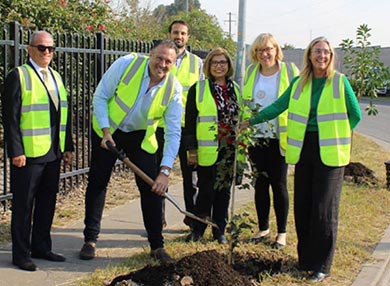 Smart Green Cities and Strathfield City Council have partnered on this project to set up a Living Lab in the Strathfield area. We seek to identify ways in which trees can improve the health, liveability and workability in harsh urban environments.
Smart Green Cities and Strathfield City Council have partnered on this project to set up a Living Lab in the Strathfield area. We seek to identify ways in which trees can improve the health, liveability and workability in harsh urban environments.
Smart Green Cities researchers are working alongside the Council and local businesses to test and identify tree species that:
This research is an Australian first, and if successful, it will be developed into best practice guidelines for other councils to implement across Australia.
Contact: anthony.manea@mq.edu.au
Funded by: Sydney Water Corporation
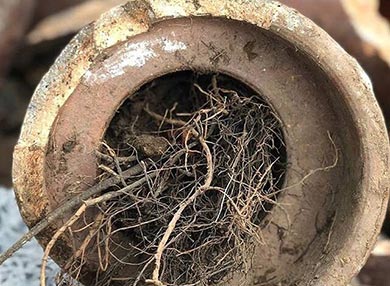 This collaborative project between Smart Green Cities and Sydney Water Corporation aims to create and validate a predictive framework of tree root intrusion risk in sewerage pipes across the Greater Sydney region using:
This collaborative project between Smart Green Cities and Sydney Water Corporation aims to create and validate a predictive framework of tree root intrusion risk in sewerage pipes across the Greater Sydney region using:
New knowledge and techniques developed by the project will lead to a national, and potentially international, evidence-based decision‐making benchmark for water infrastructure management.
Contact: michelle.leishman@mq.edu.au
The Parramatta Catchment Group is a collaborative partnership of local and state government, academic and industry organisations working towards the Our living river initiative – making Parramatta River swimmable again by 2025.
Healthy waterways are crucial to achieving liveable cities as they ensure the wellbeing of people, flora and fauna.
To do this we need to standardise policies and practices that impact water quality. This project has identified the appropriate policies, planning instruments and sustainable funding mechanisms that will support the goals of the Parramatta River Masterplan.
Smart Green Cities partnered with Civille to release a recommendations paper, Strategic and Statutory Planning Review to Create Our Living River, that sets out recommended planning reforms to:
Contact: peter.davies@mq.edu.au
Funded by: Sydney Institute of Marine Science (SIMS)
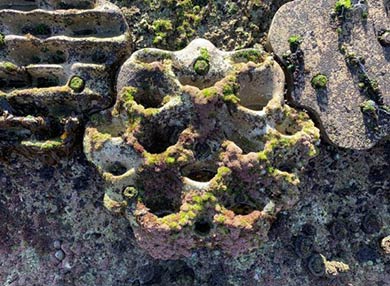 Healthy oceanic ecosystems are critical to combating climate change and its effects on people and cities.
Healthy oceanic ecosystems are critical to combating climate change and its effects on people and cities.
Living Seawalls is an initiative of the Sydney Institute of Marine Science (SIMS) with Smart Green Cities partnering on research to improve the ecological performance of seawalls and other marine built structures, thereby creating healthier oceans.
In partnership with Alex Goad of Reef Design Lab, the research team has developed habitat modules that can be attached to seawalls to increase habitat area and add missing microhabitats, such as rockpools and crevices.
Panels have been installed in several locations around Sydney Harbour. The Barangaroo underwater garden at Waterman’s Cove represents the team’s largest installation to date, with 384 specially designed marine habitat panels.
Contact: melanie.bishop@mq.edu.au
Funded by: the Australian Government
The SmartCrete CRC is a multi-disciplinary partnership led by Macquarie University that will pave the way we create sustainable cities by developing more sustainable and environmental concrete, the world’s second most used material after water.
With Australian Government funding of $21 million, the CRC aims to reduce the cost of concrete and improve productivity by facilitating research for the concrete supply chain. It provides contacts, connections and funding for successful research projects to address the various issues and challenges for concrete, especially in its application in infrastructure.
Funded by: Horticulture Innovation Australia’s Green Cities Fund
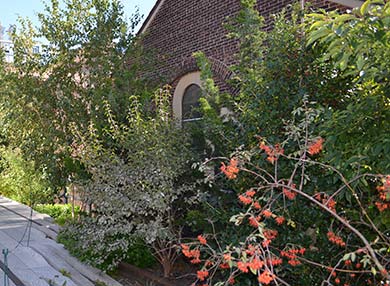 Urbanisation is putting pressure on biodiversity, water resources and human health.
Urbanisation is putting pressure on biodiversity, water resources and human health.
Green spaces:
202020Vision intended to create 20 per cent more green space in Australian urban areas by 2020. Questions arose about how to choose the right plants for the right locations under current and future climates.
The Which Plant Where project developed a national public database to identify climate-change resilient urban plants.
Our research is being done alongside growers, practitioners and industry, and includes test plantings under some of the hottest and driest conditions in Australia.
The team comprises environmental and horticultural researchers from:
Western Sydney University partners:
Contact: gwilym.griffiths@mq.edu.au
Funded by: Macquarie University Research Acceleration Scheme (MQRAS) 2022
This project helps to accelerate the development of novel power stations within renewable energy zones in regional NSW, through design and development of a microgrid in the power and renewable energy lab in Macquarie University.
This research will help identify the optimal size and location of renewable energy generators for new energy hubs in regional NSW, advancing decarbonisation and the sustainable development of the state.
Funded by: Snowy Hydro Ltd
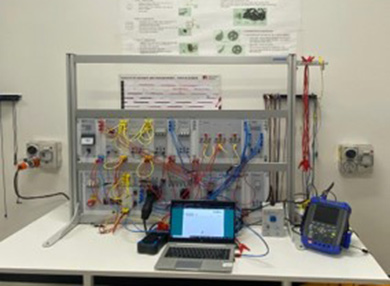 Researchers at Macquarie University wish to:
Researchers at Macquarie University wish to:
We are developing innovative charging methods and future installation of EV charging stations, in partnership with Snowy Hydro Ltd. We are undertaking a trial to pursue a stable revenue model and a long term EV adoption achievement.
Contact: sara.deilami@mq.edu.au
The centre contains researchers from every Macquarie faculty
Meet our team membersWe collaborate with researchers, government and industry
Join our networkSee our range of cross-disciplinary pilot projects
See projects we've funded